Which Sonos speaker should you buy in 2024?
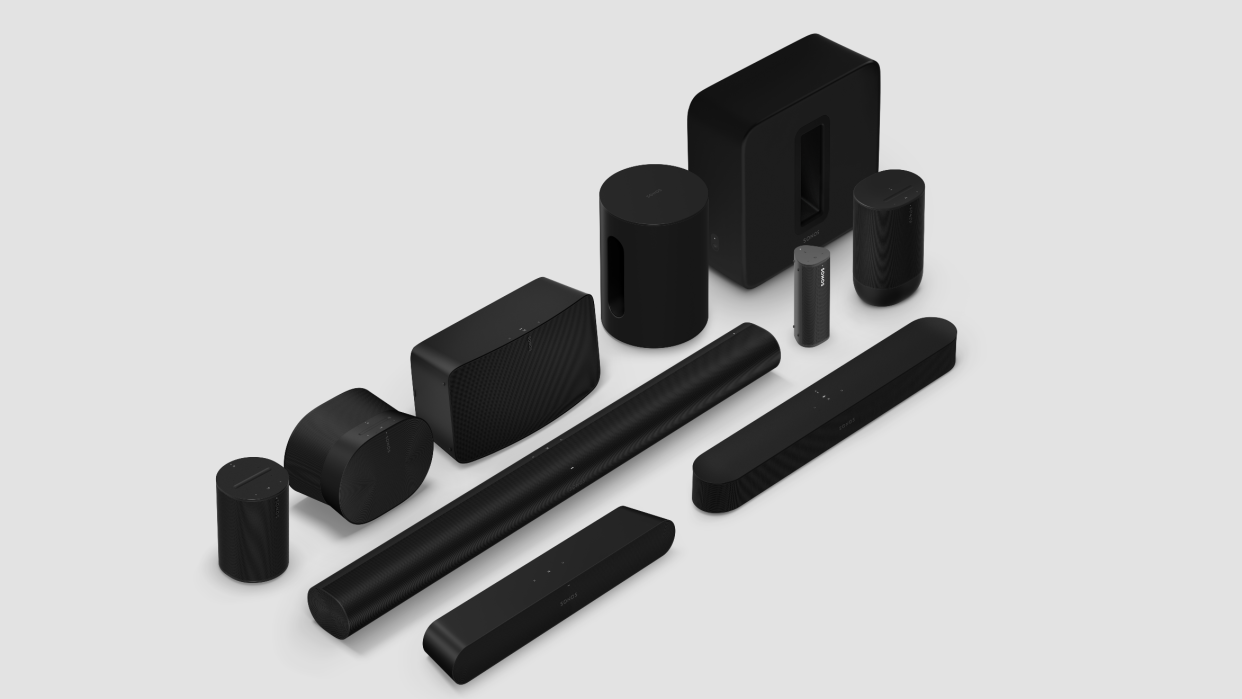
If you like the idea of multi-room audio, chances are you’ve considered Sonos. Over the last decade or so, the company has become synonymous with wireless multi-room audio, almost single-handedly shaping the market into what it is today.
With competitive sound across a wide range of products, ample support for all popular streaming services, voice control options and simple set-up, Sonos remains one of the most compelling wireless streaming solutions out there, even with the likes of AirPlay 2 (and Apple's HomePods), BluOS, HEOS platforms offering viable alternatives today in a wider range of products.
The core products in the Sonos family – from the Sonos Era 300 and Era 100 smart speakers through to the Arc and Beam Gen 2 soundbars – all share the same DNA, but it’s more than just price and size that distinguish each product. Your particular needs will determine which one(s) you should buy, and how you should configure the best Sonos setup for your home.
After years of smooth sailing, though, 2024 has seen the first shaky footsteps from a brand that is normally on incredibly steady ground. The brand's first-ever wireless headphones, Sonos Ace, didn't impress us for its premium price point, while a recent redesign to the usually fuss-free, excellent S2 platform and app launched with a few issues, with many users complaining about glitches, bugs, feature omissions and more that mar the seamless ecosystem we've come to know so well. Sonos has confirmed it will release bug fixes that should address most of these issues, and it's worth mentioning that there are many users who didn't experience any issues with the new app update too.
Whether you're considering upgrading to a current model or taking the first steps on your Sonos journey, this page running through all the Sonos speakers and soundbars you can buy should help. Not sure where to start? Here's the lowdown on the complete Sonos range...
Shop today's best Sonos deals
Explore the best Sonos accessories
Should you buy the Sonos Era 300?
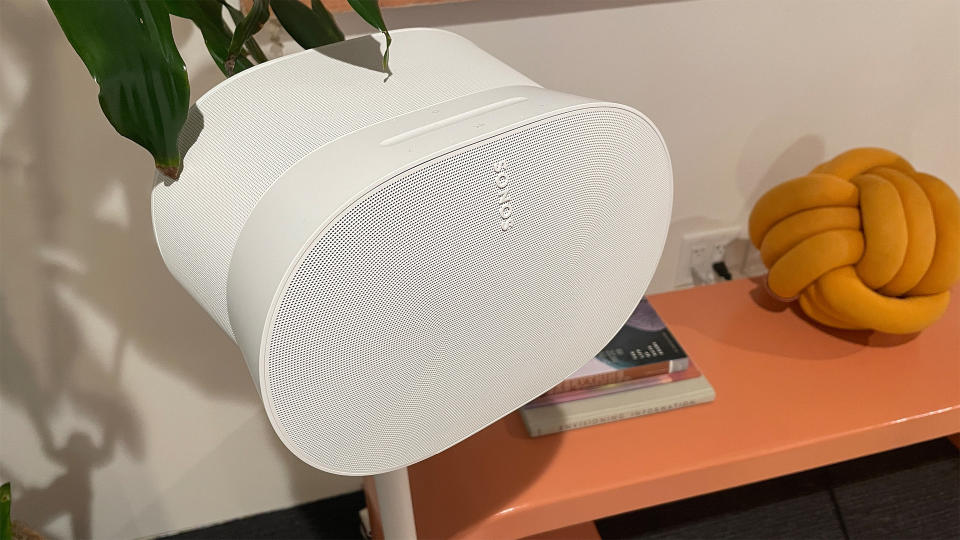
The Era 300 is one of Sonos' most ambitious and impressive speakers and has earned five stars and an Award win from us. It's the company's most versatile offering yet, with both Bluetooth and wired line-in onboard (Sonos has offered these features before, but never in the same speaker). The usual Sonos features are there too, including wi-fi 6, AirPlay 2, Sonos voice control and Alexa support (but no Google Assistant).
This speaker shares all these traits with its cheaper brethren, the Era 100 (see below). But the two are quite different propositions.
The Era 300 is built to show off spatial audio with Dolby Atmos tracks. Its unique hourglass cinched design houses six drivers (four tweeters, two woofers) with custom waveguides that fire sound out forwards, upwards, left and right to surround you with music. Each of these drivers is powered by its own class D amplifier.
The Era 300 can also be used as Dolby Atmos rears in a surround system with the Sonos Arc or Beam Gen 2 soundbars and a Sub.
Of course it wouldn't be much use if the Era 300 didn't support spatial audio via streaming services, but thankfully it does. It supports Dolby Atmos-powered spatial audio from Amazon Music, as well as spatial audio via Apple Music. That makes it the first speaker to do so outside of Apple's own devices. The Sonos Arc and Beam (Gen 2) soundbars are also gaining this feature.
There's no support for spatial audio via Tidal yet though. Hopefully it's coming soon.
Should you buy the Sonos Era 300?
If you can afford it, yes. It's Sonos's most impressive speaker yet, with an immersive sound, fantastic versatility thanks to its Bluetooth and feature-packed app, and a unique design. It offers the best example of spatial audio playback we've heard in a speaker yet, with a large-scale, open sound that's detailed and dynamic. It is quite pricey, though. And it's a shame you have to pay extra for an adapter in order to plug in wired sources – it costs £19 / $19 / AU$35.
Is it the best smart speaker at its price?
Quite possibly. It outdoes even the Apple HomePod 2 (£299 / $299 / AU$479) in terms of sonics – Apple's smart speaker sounds positively small next to the Era 300. Though as we say, at £449 / $449 / €499 / AU$749, the Era 300 is very expensive. If you can stretch to it, you won't be disappointed.
Read our full Sonos Era 300 review
Full comparison: Sonos Era 300 vs Apple HomePod 2
Op-ed: The Era 300 is everything I want, but it’s just too expensive
Here's why one writer believes the Era 300’s spatial audio isn't a gimmick
Should you buy the Sonos Era 100?
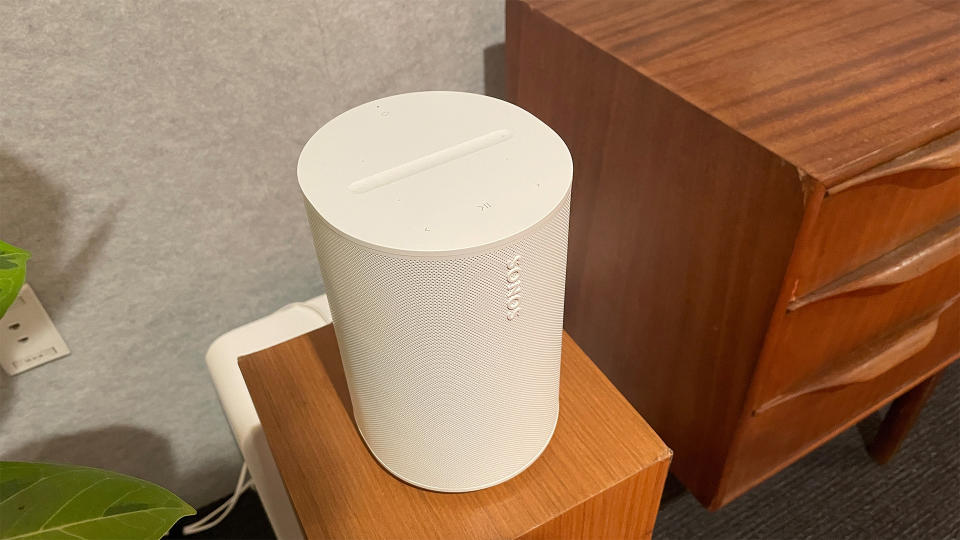
The new five-star Era 100 replaces the old five-star Sonos One, and shares many of the same abilities as the Era 300 (above). It too has Bluetooth 5.0, wi-fi 6, AirPlay 2, Sonos voice control and Alexa support, as well as a USB-C line-in. Also like the Era 300, it can handle audio files up to 24-bit/48kHz, and has the same new top panel interface with touch capacitive controls.
But the design is a lot more conservative. That's because it's designed to deliver stereo sound, but can't handle spatial audio. This is still an upgrade over the Sonos One though, which was only mono.
Inside are three class D amplifiers powering two angled tweeters with custom waveguides and a 25 per cent bigger woofer for a fuller low end. You can pair two Era 100s together, and they can also be used as rear speakers with the Arc, Beam Gen 1 and Beam Gen 2, and Ray Sonos soundbars.
Should you buy the Sonos Era 100?
This one is rather straightforward: if you want an entry point into the Sonos ecosystem, the new Era 100 is a terrific way in. It's better than the outgoing Sonos One in nearly every way – although the latter is still a decent buy if you get a great deal. It also has a richer way with voices. But the Era 100 sounds bigger, is more detailed and more open, digs deeper into the bass and simply blows the One away sonically.
Is it the best smart speaker at its price?
Also again, competition here is fierce. At £249 / $249 / €279 / AU$399, the Era 100 is pricier than the Sonos One (now £180 / $220 / AU$320), Apple HomePod Mini (£99 / $99 / AU$149) and Amazon Echo (4th generation) (£90 / $100 / AU$149). In fact, it's around the same price as the Amazon Echo Show 10 (3rd generation), which has a 10-inch screen. The excellent Apple HomePod 2 is also only £50/$50 more expensive and offers a more nuanced, textured sound delivery. But the Era 100 hold its own with a wider range of features; it offers plenty for the money.
Read our Sonos Era 100 review for the full verdict
Full comparison: Sonos Era 100 vs Sonos One
Should you buy the Sonos Roam?
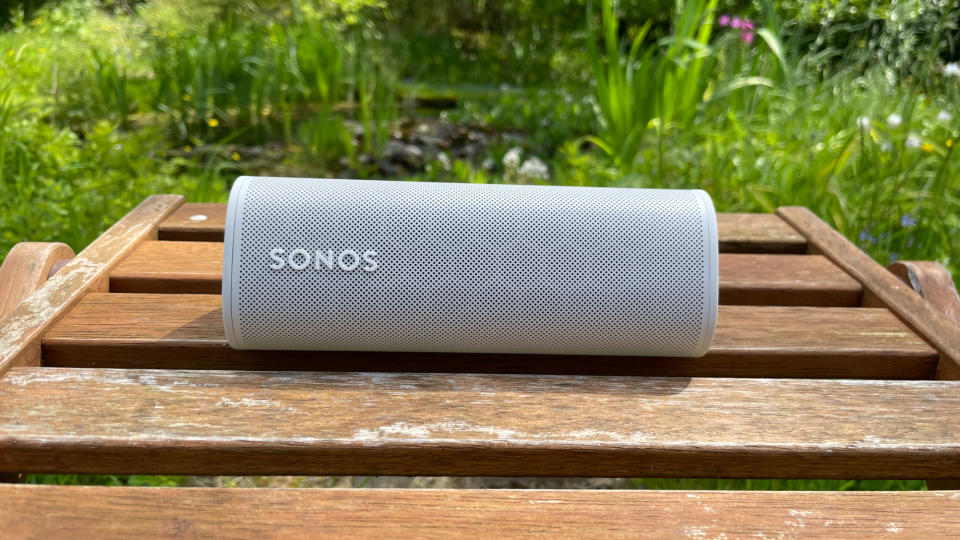
The Sonos Roam is the firm's cheapest smart speaker, and is now replaced by the newer Sonos Roam 2. Portable and with Bluetooth and wi-fi connectivity, the Toblerone-shaped Roam is a great alternative to the company's first Bluetooth speaker, the 2019-released Sonos Move (below).
Designed for both indoor and outdoor use, the Roam is rated IP67 waterproof and boasts a 10-hour battery life – despite being a sixth of the size of the Move. It comes with an excellent bag of tricks, too.
Sonos Swap (exclusive to the Roam) lets you 'hand off' whatever music the Roam is playing to another Sonos speaker nearby, while improved Auto TruePlay uses the speaker's microphones to optimise the sound according to the speaker's surroundings.
Not bothered about access to smart assistants? Sonos has a microphone-free version of the Roam, which we'll get to in a moment.
Should you buy the Roam?
Want the smallest and smartest speaker in the Sonos range? The picnic-friendly Roam could be just the ticket. Sound quality is full-bodied but there are plenty of other Bluetooth speakers around that provide a more detailed and dynamic performance. Does that matter? Not really – not when you factor in the Roam's nomadic abilities, AirPlay 2 support and robust build quality. The new, streamlined Roam 2 brings in a dedicated Bluetooth button for pairing (which is better than the arrangement on the original Roam), you don't need to connect to wi-fi or the Sonos app first to activate Bluetooth pairing, and it costs £179 / $179 / AU$299. Otherwise, the features and sound are reportedly identical.
Is it the best portable wireless speaker for its price?
The Roam is unique in that it's the only Sonos smart speaker at this price that integrates into the wi-fi Sonos ecosystem. If that USP isn't actually a big deal for you, mind, know that you can get better sound for the money elsewhere (and sometimes for much cheaper) – from the JBL Flip 6, JBL Charge 5, Audio Pro Addon C3 and Bang & Olufsen Beosound A1 (2nd Gen), for example.
Read our full review of the Sonos Roam
Sonos showdown! Sonos Move vs Sonos Roam
Sonos Roam 2: release date rumours, potential price and what features to expect
Should you buy the Sonos Roam SL?
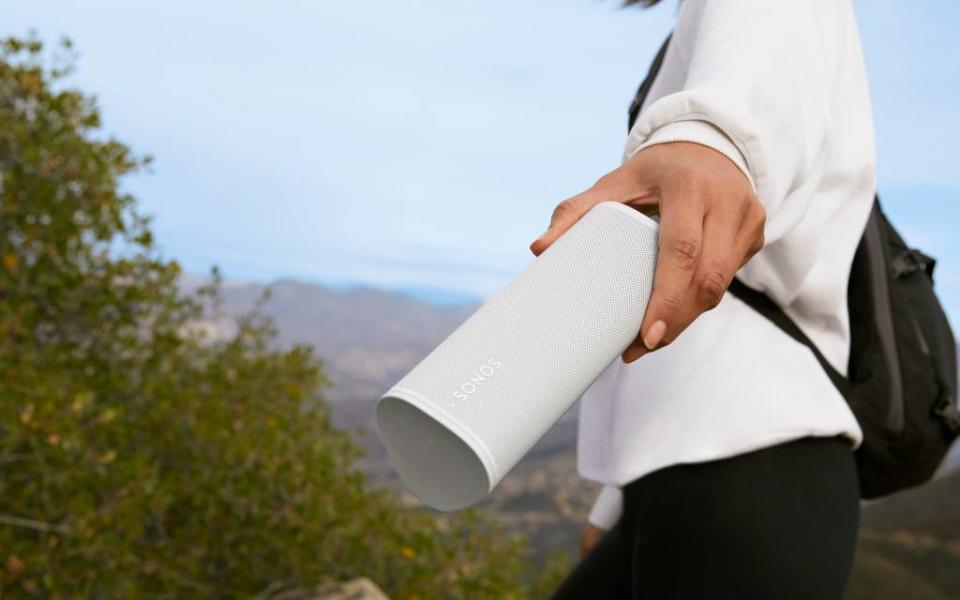
The Sonos Roam SL looks almost identical to the original Roam (above) but lacks a microphone. The mic-free Roam comes with a price cut, making it even more affordable than its sibling.
Losing out on the microphone means you lose out on voice-activated controls via Alexa and Google Assistant. The Roam SL also does away with Sonos' Auto Trueplay and SoundSwap features, as both require a microphone.
That aside, the Roam SL mimics the Roam with an IP67-rated waterproof design, Bluetooth, wi-fi and AirPlay 2, dual Class-H amplifiers, Qi wireless charging capability and more. Functions can be controlled via the superb Sonos app.
Should you buy the Roam SL?
If you want Sonos' cheapest Bluetooth speaker, the Roam SL has your name written all over it. We've yet to review the SL in full, but it's shaping up to be a great entry-level option.
Is it the best portable wireless speaker for its price?
We'll have to reserve judgement until we've run the rule over every aspect of the Sonos Roam SL, but on paper, it's a tempting proposition for those who want to dive into the Sonos ecosystem at the lowest price point.
Where can I buy the Roam SL?
The Sonos Roam SL was announced on 1st March 2022. You can buy it from sonos.com for £159 / $159 / AU$269.
Sonos Roam SL vs Sonos Roam: which is the best portable speaker for you?
Should you buy the Sonos Move 2?
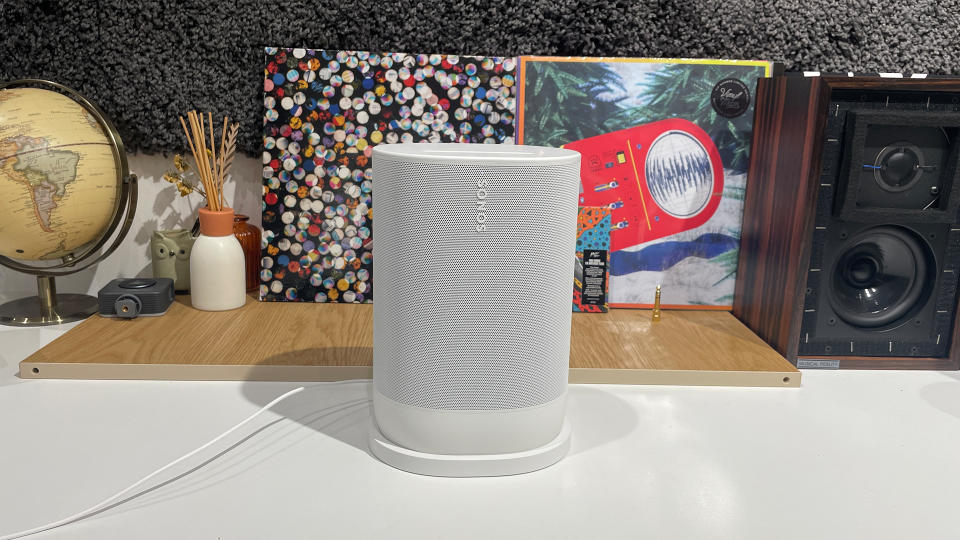
Launched in 2019, the Move was Sonos's first-ever portable Bluetooth speaker, giving users the option to take their audio into the garden, or even into the bathroom to keep them company.
The new Move 2 arrived in September 2023, and while the large-ish speaker hasn't changed much in essence, it does bring in stereo sound and a longer battery life of 24 hours, as well as some refined design and user-friendly tweaks. And a higher price tag than before, at £449 / $449 / AU$799.
As you'd expect, the Sonos Move is as much a Sonos wi-fi speaker as those before it – you get network music streaming, multi-room smarts and voice assistant – but it's big, heavy and expensive compared to the Sonos Roam.
That said, the Move 2's 3kg heft, two angled tweeters and woofer with Class D amplification enable it to deliver weighty sound that is spacious, loud and entertaining. All in all, it does a fine job of delivering the Sonos experience in a portable-ish package. It also features Auto Trueplay tuning, AirPlay 2 and an IP56-rated dust and water-resistant design.
Should you buy the Move?
If you want a light, portable, Bluetooth Sonos speaker, you'll want to consider the smaller, smarter Roam. However, while the Move 2 is heavier and more expensive, it also delivers a sense of scale and weight that the Roam cannot match.
At £449 / $449 / AU$799, though, the Move 2 is rather expensive. You can buy the Era 300 for the same money, which is astonishing to us. The Era 300 will give you a more powerful sound and it's better with detail, timing and punch, too.
Is it the best portable wireless speaker for its price?
If you want a significantly sized Sonos speaker that is portable, the Move 2 (and the older Move) is the only speaker to match your requirements. But if you're more interested in portability and performance than Sonos wi-fi features, you can get better sound-per-pound value from the Dali Katch G2, Audio Pro Addon C3 and JBL Xtreme 3.
Read our Sonos Move 2 review
See how the Sonos Move 2 vs Move compare
Best Bluetooth speakers: portable speakers for every budget
Should you buy the Sonos One?
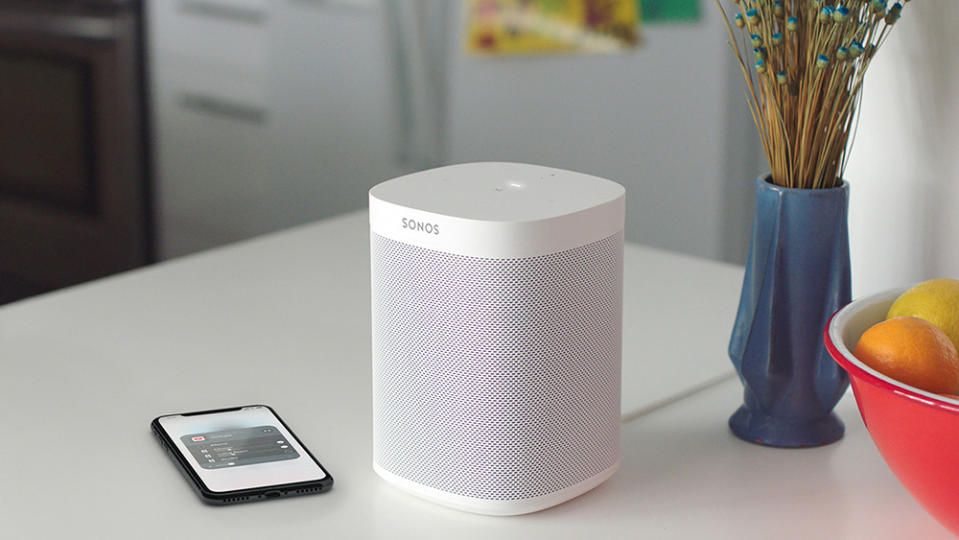
The Sonos One is being replaced by the Sonos Era 100 (see above). But it will stay on sale until stock runs out.
This plug-in wireless speaker is a revamped version of the now-discontinued Play:1 with Amazon’s Alexa voice-control built-in – and it passes its smart test with flying colours. The One's solid, detailed, spacious and organised presentation impresses, and its Alexa is as seamless to use as on Amazon’s own speakers. Yes, it sounds smaller and less detailed compared with the new Era 100, but musically, it still hangs together well.
It has the crucial feature of being able to use Alexa to control Spotify, and it even supports AirPlay 2 and Siri, with Google Assistant support offering an alternative means for voice control. The One is easily one of the most well-specified and versatile smart speakers around, and a great way for existing Sonos users to affordably expand their multi-room set-up around the house.
Should you buy the Sonos One?
You wouldn’t buy the Sonos One just for its AI smarts. But it's a great perk that's hard to ignore. If you want a good-sounding wireless speaker that’s your stepping stone into the world of multi-room streaming (especially the convenient, feature-packed Sonos one) that just happens to have the added bonus of voice control – all for an affordable sum – then the One is the one for you. Don't care for voice control? Save some money and get the cheaper Sonos One SL (below) instead.
Is it the best smart speaker for its price?
The One is one of the best-sounding smart speakers for the price (if you're looking for a cheaper option, there's the Apple HomePod Mini) and a great way to kickstart or expand a Sonos multi-room system. The new Era 100 that replaces it does offer Bluetooth and a line-in connection (but no Google Assistant), and an improved, bigger, more detailed stereo sound. It's a better buy in the long run, but the One is still a great option, especially at its discounted price.
Read our Sonos One review
Our guide to the best smart speakers for every budget
Sonos Era 100 vs Sonos One: which smart speaker should you buy?
Should you buy the Sonos One SL?

The second cheapest smart speaker in Sonos's range after the Roam, the One SL is essentially a Sonos One (above) without voice control. To that end, it looks almost identical to the Sonos One, with a touch-sensitive top plate and pairing button at the back. And it sounds like one too, which is to its credit; the Sonos One sounds excellent.
The sonic performance, streaming options and app support are among the best we’ve tested at this level.
Should you buy the Sonos One SL?
If you don't care for voice control and simply want Sonos integration, the One SL makes a lot of sense for you and your bank account. But it also serves another purpose for those who do want voice control: to work in a stereo pair with the One. Pair a One and One SL together in stereo – a set-up that looks and sounds good for the money – and you’ve created a pair of stereo speakers where the One can handle voice activation.
Is it the best wireless speaker for its price?
If you're keen to benefit from Sonos multi-room, absolutely. We'd also argue that the Sonos One with voice control for just £20 ($20, AU$30) more is better value, but why pay extra for something you aren't going to use? If, however, you'd be happy without the Sonos element, a great alternative is the Audio Pro Addon C3 (which is also portable).
Read our Sonos One SL review
Should you buy the Sonos IKEA Symfonisk bookshelf speaker?
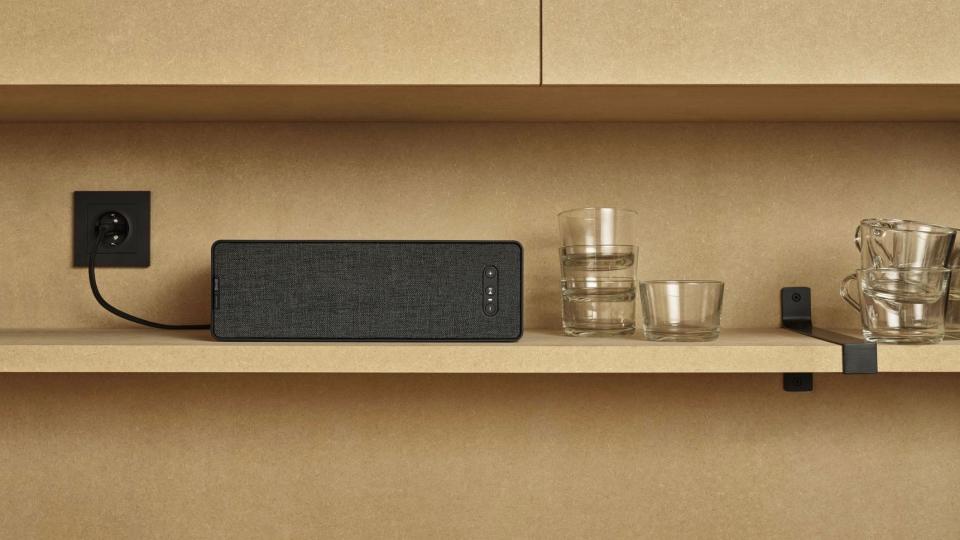
We didn't know what to expect when IKEA and Sonos first released a bookshelf that could sing... but the results are actually quite impressive. The Sonos IKEA Symfonisk wi-fi bookshelf speaker can be wall-mounted (or stand upright) and hold up to 3kg of books, ornaments or any other clutter you decide to place upon it. But as well as that, it also has all the Sonos wireless multi-room functionality you'd expect.
While this cheap speaker was never likely to rival the Sonos One or One SL for sound quality – and doesn't – the same character is there. This Symfonisk bookshelf speaker sounds bold and focused, only lacking a little refinement compared to the best speakers at this price.
In 2022, Ikea released an updated version of the bookshelf speaker. The latest model boasts a faster processor, more memory and lower power consumption when in standby mode. IKEA has also added a longer power cable and streamlined the button layout.
Should you buy the Sonos IKEA Symfonisk bookshelf speaker?
Do you like the design? Do you want a Sonos speaker that's also a bookshelf? Do you want the most affordable way to get a piece of the Sonos magic? Look no further. But if you value sound quality and are prepared to spend a little more, we'd go for the Sonos One or One SL instead.
Is it the best wireless speaker for its price?
You’re not going to get a better-sounding multi-room speaker with Sonos’ sonic signature for less than three figures – not to mention one that you can use as a floating bookshelf. Again, if you prioritise sound quality over Sonos and wi-fi features, the best Bluetooth speakers at this price, such as the JBL Flip 5, can offer more refinement and generally slightly better overall performance.
Should you buy the Sonos IKEA Symfonisk lamp speaker (2021)?
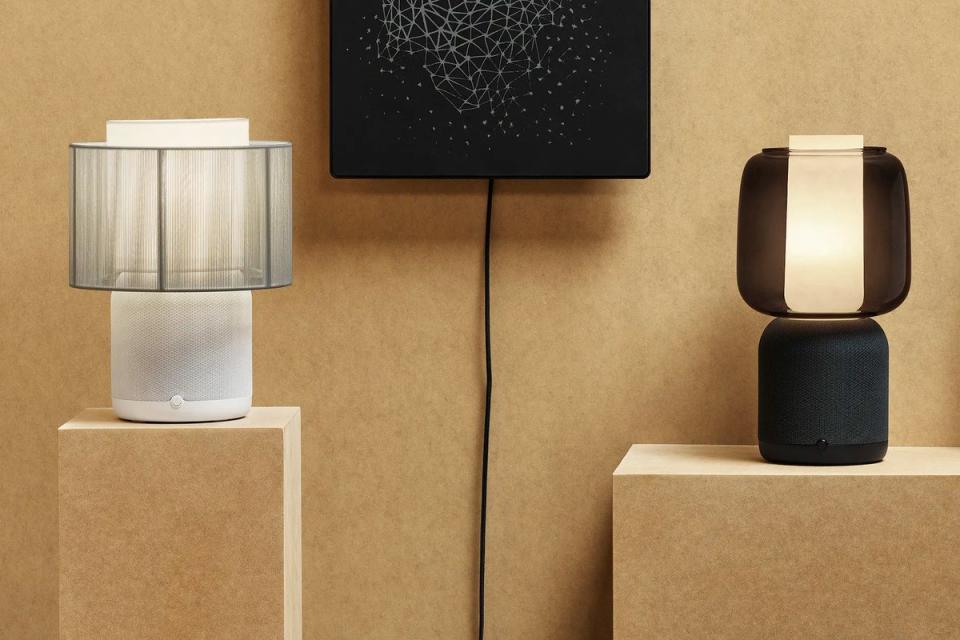
IKEA and Sonos's second-generation Symfonisk table lamp is official. This time round, you can snap up the base separately, pairing it with two different types of shades – a glass offering, or a softer fabric shade.
The bases and shades are available in black and white, while a revamped design shifts the controls over to the lamp itself. This makes for a sleeker design, as the new base has ditched the foot section of the original model, which previously housed the controls.
New acoustic architecture has been promised along with the makeover, with continued support for AirPlay 2 and, naturally, Sonos multi-room audio. Unlike the original, it also features a "custom waveguide" which apparently offers "a wider and more room-filling sound", regardless of where you place it. It's compatible with a wider range of bulbs too, thanks to a new E26 / E27 socket.
We were impressed with the sound offered by the original lamp, so while we haven't gone twelve rounds with the new Symfonisk table lamp yet, we have high hopes for an even better experience here.
Should you buy the Sonos IKEA Symfonisk lamp speaker?
There is nothing else quite like it on the market, but the real plus is that you aren’t forced wholly to sacrifice sonic prowess to accommodate the quirky design. And again, it's one of the most affordable ways to introduce Sonos technology into your home – more than the Sonos IKEA Symfonisk bookshelf, less than the One and One SL.
Is it the best wireless speaker for its price?
Such is the uniqueness of this speaker that, as with the Sonos IKEA bookshelf speaker, there's nothing strictly comparable to it. If you are happy to forgo the lamp design for a more traditional-looking speaker, we'd go for the only slightly pricier Sonos One SL for its superior sound quality.
Should you buy the Sonos IKEA Symfonisk picture frame?
The Symfonisk Picture Frame WiFi Speaker promises room-filling sound from "a beautiful piece of art". It's essentially a flat-panel wireless speaker that can be mounted on a wall or stood on a shelf using its kickstand. IKEA offers a range of interchangeable fronts to match your interior decor.
The frame measures 22in by 16in and is 2in deep while its 138in power cable can be coiled up and stashed in the clever rear storage area. There are two finishes to choose from: black and white.
Physical controls are located on the left side of the frame, but most users will likely opt to control the speaker with the Sonos S2 app. AirPlay 2 support is also included and two picture frame speakers can be stereo paired.
Should you buy the Sonos IKEA Symfonisk picture frame?
We've yet to review this model but if you're short on space and are drawn to the idea of a 'wall of sound', this device could be right up your alley.
Is it the best wireless speaker for its price?
The Symfonisk Picture Frame WiFi Speaker launched at £179 / $199 (around AU$290), so it's relatively affordable for a Sonos speaker. But whether it can match the sound of the similarly-priced Sonos Roam remains to be seen.
Should you buy the Sonos Five?
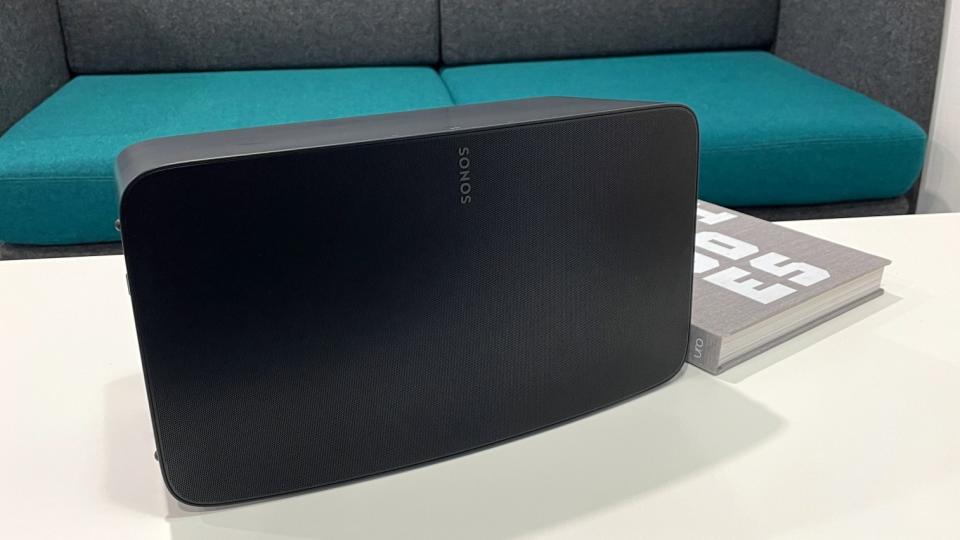
The 2021-launched Sonos Five is a beefy, all-in-one wireless streaming speaker that looks and sounds a lot like its predecessor, the Play:5.
We awarded the Five four stars in our review. It retains all the features that made its predecessor popular – including a 3.5mm line-in for an external source and the ability to orientate the speaker in three ways – but adds improved wi-fi connectivity.
The driver arrangement also mimics the older Play:5 – six class D amplifiers powering three 10cm mid-woofers and three tweeters. Each Five speaker can be switched to mono for a more traditional stereo pair configuration, or you can use them as rear surrounds with a Sonos Arc soundbar.
Should you buy the Sonos Five?
Sonos' flagship wireless speaker is a great choice for those who want a standalone wireless speaker that goes big and loud, or who want to build a complete multi-room or home cinema system. But we found it rather less expressive and dynamic compared with the newer Era 300, with a slightly rounded-off treble and a leaner presentation. And there are plenty of alternatives that offer Bluetooth, which the Five lacks.
Is it the best wireless speaker for its price?
The Five has two key omissions: it lacks voice controls and Bluetooth. And there are better-sounding smart speakers for the money, namely the Apple HomePod 2. Not to mention competition from within, with the new spatial audio-supporting Era 300 launching for similar money and offering a more capable, richly detailed sound overall (and more features, including voice control, for less money). If you're already deep in the Sonos ecosystem, the Era 300 is the better option, while if you're a big Apple fan, the HomePod 2 might be for you instead.
Read our full Sonos Five review
Sonos Era 300 vs Sonos Five: which high-end Sonos speaker is for you?
Should you buy the Sonos Beam Gen 2?
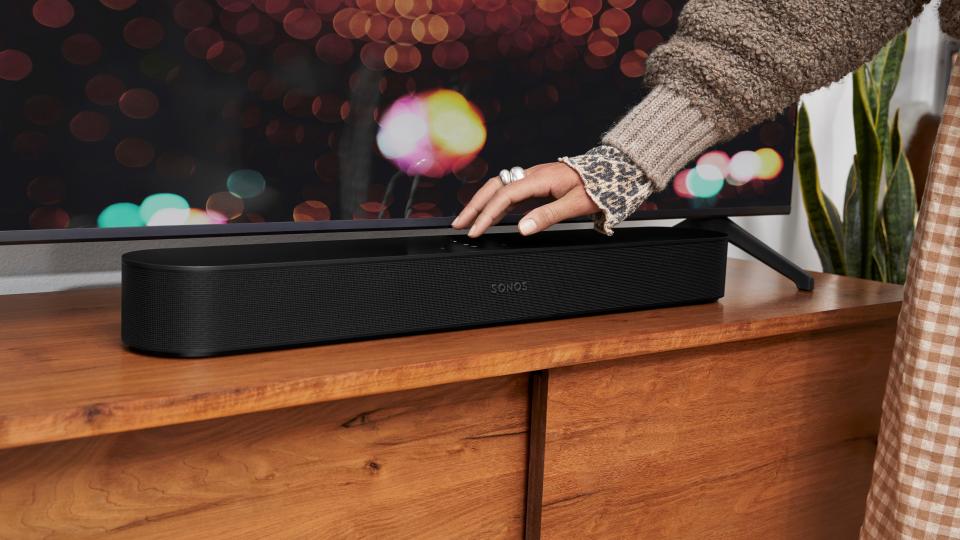
The Sonos Beam Gen 2 is a direct replacement for the multi-award-winning original and has some pretty big shoes to fill. It aims to up the ante by cramming in Dolby Atmos capabilities into the same minuscule form factor, and achieving this without any upward-firing speakers, no less.
It sounds like a crazy risk but, as you can read in our Beam Gen 2 review, we can confirm that its use of forward-facing drivers (configured into five separate arrays rather than the original's three), combined with more processing power, results in a product that's even better than the original.
The result is a soundbar that can handle Dolby Atmos more capably than many more expensive soundbars with actual upward-firing drivers. It creates a more spacious soundscape, with an impressive sense of height.
Atmos aside, it sounds incredible, besting the Gen 1 with more refinement, a warmer treble, and a wider dynamic range. Overall the listening experience is richer, more nuanced, and varied. And that's without even mentioning the return of the usual features like Apple Airplay 2, Alexa and Google Assistant support, and eARC connectivity.
Should you buy the Beam Gen 2?
The compact dimensions are ideal for those who can't fit the larger, pricier Sonos Arc into their homes, though getting the full spectrum of Sonos's multi-room and streaming features for a more affordable price will be hugely popular too. That said, if the original (non-Atmos) Beam is heavily discounted, that could well be a better-value option for those on a budget.
Is it the best soundbar for its price?
Ultimately, the Beam Gen 2 is comfortably the best Dolby Atmos soundbar at this price point, and these days there aren't many non-Atmos soundbars at the budget end of the market to heartily recommend either. There is one, though: the Yamaha YAS-207. If you don't mind sacrificing streaming features and Atmos, this excellent-sounding and great-value soundbar and subwoofer combo is hard to argue with.
Read our Sonos Beam Gen 2 review
Sonos Beam Gen 3 preview: 4 things we want from the next budget Dolby Atmos soundbar
Our pick of the best soundbar deals
Should you buy the Sonos Arc?
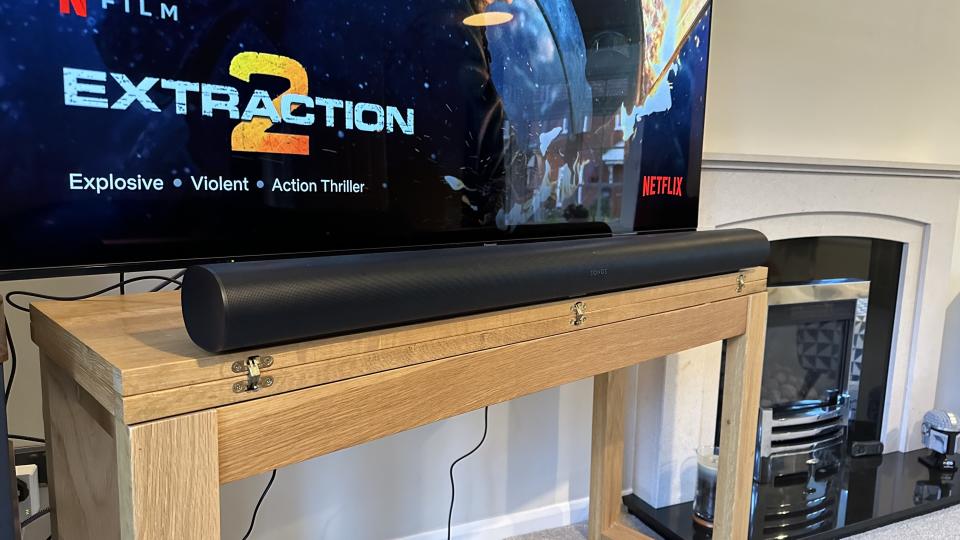
The Arc is Sonos's stunning premium Dolby Atmos soundbar. In our review, we called it "simple to set up, lovely to live with and supremely capable". It's a What Hi-Fi? Award winner in the soundbar category too, if you needed further convincing.
The Arc is certainly big – at 114cm wide, it is a bit wider than a typical modern 49in TV – so it's best partnered with a 55in TV (for comparison, the Playbar is 90cm wide). But if you can accommodate it, you won't be sorry.
The Arc supports eARC (Enhanced Audio Return Channel) so it can handle Dolby Atmos signals from compatible TVs. And unlike the Beam, it packs upward-firing speakers to more convincingly and effectively deliver Atmos content. In short, it delivers one of the most convincing Atmos presentations of any soundbar we’ve heard.
Should you buy the Arc?
If you want one of the most convincing surround sound performances from a soundbar on the market, plus all the usual Sonos functionality built-in, the Arc would be an inspired choice. The Sub can be added for more grunt (although we don't feel it necessary) and other Sonos speakers like the Era 300, Era 100, Sonos One can be used as dedicated surrounds if you wish, just as with the Beam (above) and Playbase (below). The Arc is also one of the few Sonos products that work with the Sonos Ace headphones at launch, with the compatible TV Audio Swap feature letting you beam the audio from the Arc to the Ace (and vice versa) with just one tap.
Is it the best soundbar for its price?
It certainly is! In fact, we don't think it's bettered until you reach the Sony HT-A7000 (£1199, $1300, AY$1699), which is also a single-bar offering. The Sony adds more width to the soundstage and its forward projection is more convincing, while its bass is also the most taut, controlled and powerful we've heard from a one-bar proposition.
Read our Sonos Arc review
Read the full review of the Sonos Ace headphones and its home cinema features
Should you buy the Sonos Arc SL?
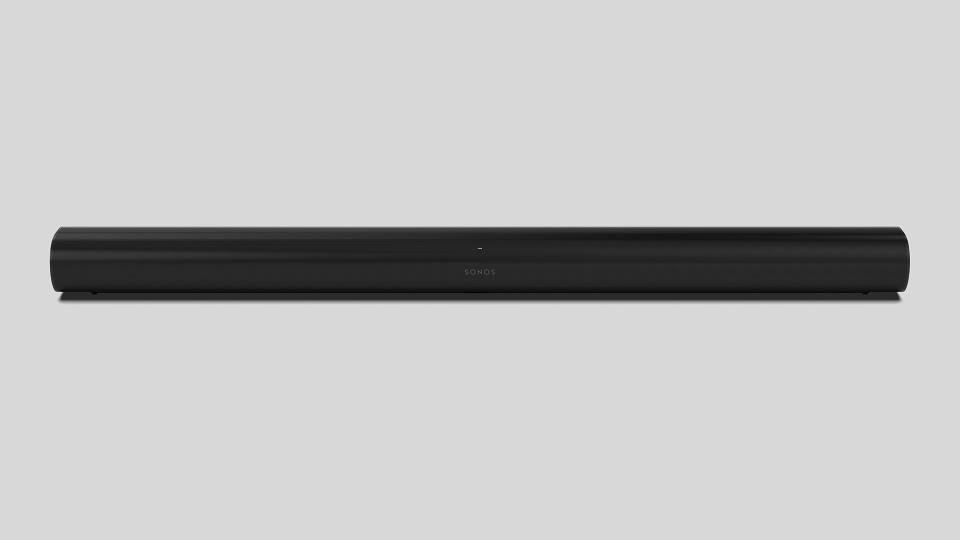
If you're on a tighter budget, Sonos offers a cheaper, mic-free version of the Sonos Arc called the Arc SL. Because there's no built-in microphone, you can't speak to control it (it's much the same proposition as the mic-less Sonos One SL) but you can easily add voice controls by wirelessly connecting the Arc SL to a voice-enabled speaker such as the Sonos One, Amazon Echo or Google Home. Indeed, you might already have such a speaker in your home, in which case the Arc SL could be a canny buy.
It looks identical to the Arc and is just as capable as filling large rooms with immersive Dolby Atmos sound at a slightly more affordable price. The Arc SL is currently available at Costco in the US and Canada, for around $50 less than the Arc. Costco also carries this exclusive Arc SL 'Shadow Edition', which is the same product in a fetching dark grey finish. There's still no word on when the Arc SL will arrive in the UK, if ever.
Should you buy the Arc SL?
If you want convincing surround sound performance from one of the finest soundbars on the market, but you're not bothered about built-in voice controls, the Arc SL is a smart buy over the standard Arc.
Is it the best soundbar for its price?
Yes indeed. Like we said of the Sonos Arc (above), we don't think its performance is bettered until you reach the Sony HT-A7000 (£1199, $1300, AY$1699), which simply adds more width to the soundstage and has bass that's also the tautest, most controlled and most powerful we've heard from a one-bar proposition.
Our definitive guide to the best Dolby Atmos soundbars
Should you buy the Sonos Ray?
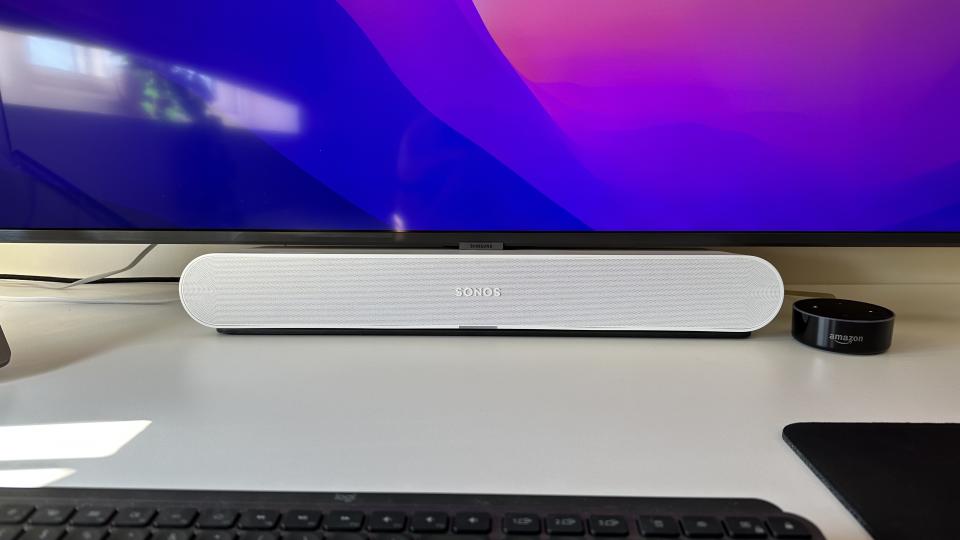
If your budget is even tighter still, you could opt for the Sonos Ray, the company's cheapest soundbar ever. At just £279 / $279 / AU$399, it's a much more affordable proposition than the Beam Gen 2 or Sonos Arc.
We're not used to seeing Sonos compete at the budget end of the market, and unfortunately, its inexperience shows. Because while the Ray is an assertive, punchy soundbar, it did struggle with an annoying bass buzz at the lower end of the frequency range. It's a shame, but it has since been rectified via a firmware update.
Other than that, the Ray is an enticing prospect. Despite its small dimensions, its sound is admirably room-filling, with excellent vocal clarity and a detailed high end. Compromises? There's no HDMI socket, no Dolby Atmos and no Bluetooth. But it does fit seamlessly into the Sonos ecosystem, partnering wirelessly with other Sonos speakers to create a full home cinema package.
Should you buy the Sonos Ray?
If you want help making dialogue more intelligible while boosting your overall TV sound without spending too much, then quite possibly. We initially gave it three stars out of five because of that buzzing sound – since it was fixed, we upped that score to four.
Is it the best soundbar for its price?
No. The JBL Bar 5.0 MultiBeam may have launched at a higher price, but can now be picked up for less than the Ray. It packs full-bodied presentation, Virtual Dolby Atmos and multi-room options to boot.
Read the full Sonos Ray review
Should you buy the Sonos Playbase?
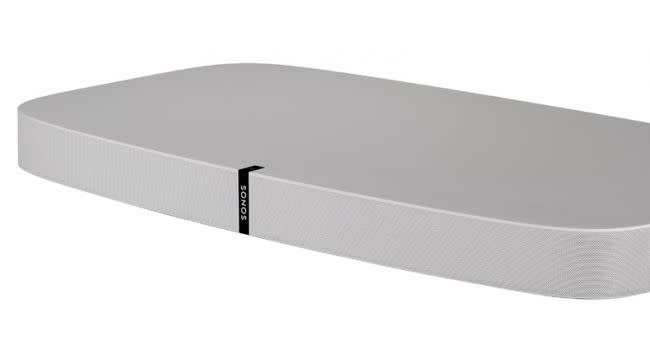
Like the Sonos Playbar soundbar (which now isn't widely available), the Playbase has now been discontinued (but is Sonos S2-compatible). Stylish yet sturdy enough to plonk your telly on top of, the Playbase makes perfect sense if you don't fancy using a soundbar. In fact, it's the only Sonos option if you're set on the soundbase form.
This Sonos product isn't flawless. Despite its huge, airy soundstage and energetic, solid bass (which sounds more natural than the Playbar) there's a sibilance to the treble that can be hard to ignore. It's punchy and dynamic, though, so we'd recommend giving it a try before you buy.
It's a breeze to use when going multi-room and you still get access to all those streaming smarts, but like the Playbar the lack of HDMI connections is something worth bearing in mind.
Should you buy the Playbase?
The Playbase isn't perfect, but the core Sonos features we love – its ease of use, the extensive streaming features, the great S2 app – are all present. It's a sure step up from your flatscreen TV's sound, and there isn't any other soundbase that packs in so many useful features into one streamlined box. What's more, it is currently the cheapest it's ever been.
Is it the best soundbase for its price?
Soundbases appear to have had their day; there aren't many around any more. People clearly prefer soundbars that sit in front of your telly to soundbases that are designed to go underneath them. That said, if that isn't you, the Sonos Playbase is a very decent option and, yes, probably the best one out there for its significantly reduced price.
Read our Playbase review
Should you buy the Sonos Sub?
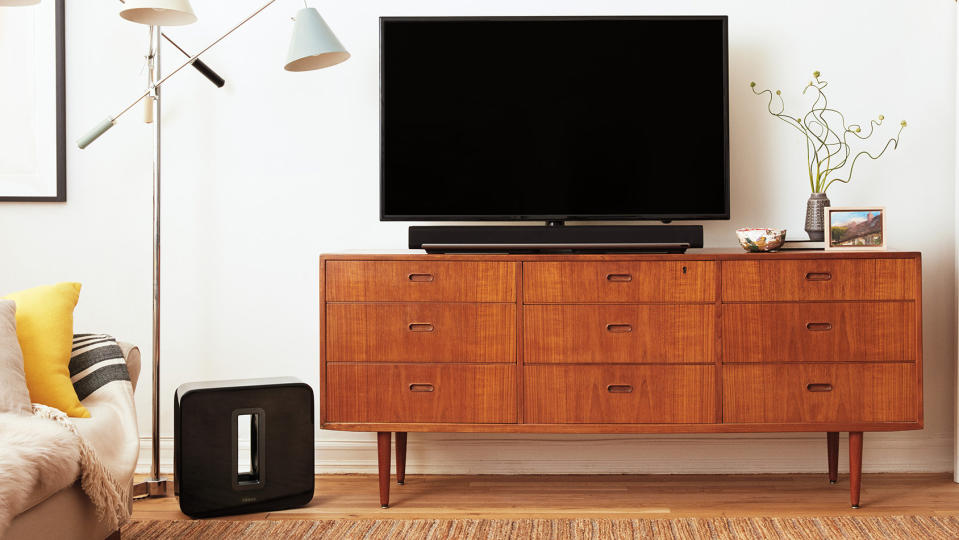
Sonos' first wireless subwoofer is a solid addition to a Sonos music or cinema system. It's 16kg, and fairly large, but its novel design allows it to stand upright or be laid flat. Connections are minimal. There’s a power supply, an ethernet input should you prefer to make a wired connection, and that’s your lot. You should also consider the newer Sub Mini (below).
Should you buy the Sonos Sub?
The Sub will work wirelessly with any Sonos speaker, Sonos Amp, or Connect:Amp, so you can add it to a music system or one aimed more at home theatre. A press of the button on the front connects it to your existing Sonos network. If you like the idea of a Sonos Sub that's easy to set up, sounds good and improves your system, this is a good buy.
Is the Sonos Sub the best sub at this price?
It’s expensive compared with standard subwoofers, but then it’s wireless and built specifically for the Sonos system – itself not a cheap proposition. Ultimately the Sonos Sub does a great job of adding bass but some of the best subwoofers are cheaper.
Read our Sonos Sub review
Should you buy the Sonos Sub Mini?
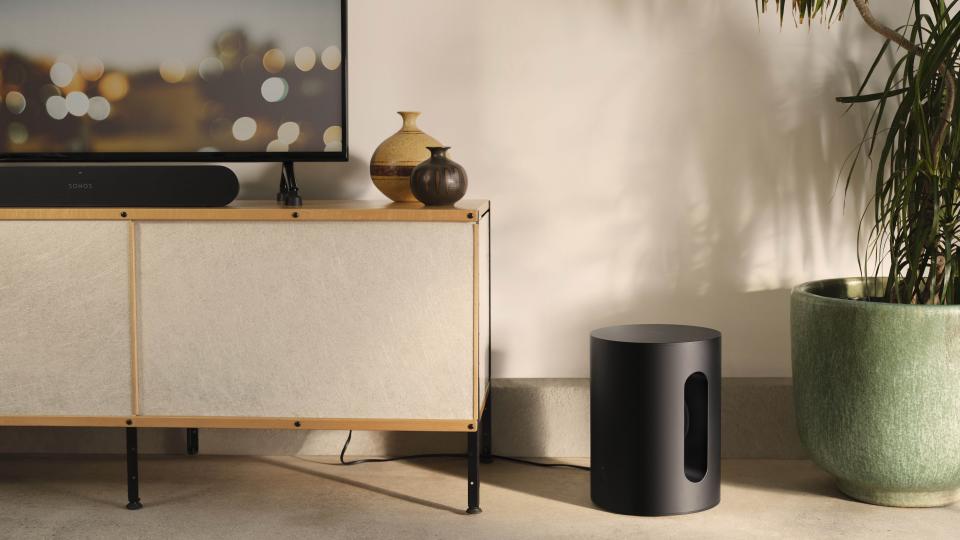
Unveiled in September 2022, the Sub Mini aims to bring a serious slug of bass to even the smallest of rooms. Despite its compact size – it's just 30.5cm tall – the Sub Mini packs in a pair of 6-inch woofers powered by a class-D amplifier. The result? A claimed low-frequency response down to to 25 Hz. We rated it four stars praising its snappy delivery.
Should you buy the Sonos Sub Mini?
The Sub Mini delivers on Sonos’ aim to bring a big sound to small spaces with a carefully controlled and quick performance that can combine easily with a variety of the brand’s speakers. It’s with the Beam Gen 2 that Sub Mini gives its best performance, and we’d avoid pairing it with the Ray. But ultimately, if you have a budget of £900 / $900 / AU$1500 to spend on a soundbar system, a solo Arc will deliver a more cinematic experience.
Is the Sonos Sub Mini the best sub at this price?
It’s not remarkably detailed or tonally sophisticated but it unlocks more scale and depth from film soundtracks and music and does so, on the whole, without drawing attention to itself. At £429 / $429 / AU$699, it's both pricey and of limited appeal. We'd suggest that you peruse our guide to the best subwoofers before cracking open your piggybank.
Read our Sonos Sub Mini review
So, should you buy a Sonos multi-room system?
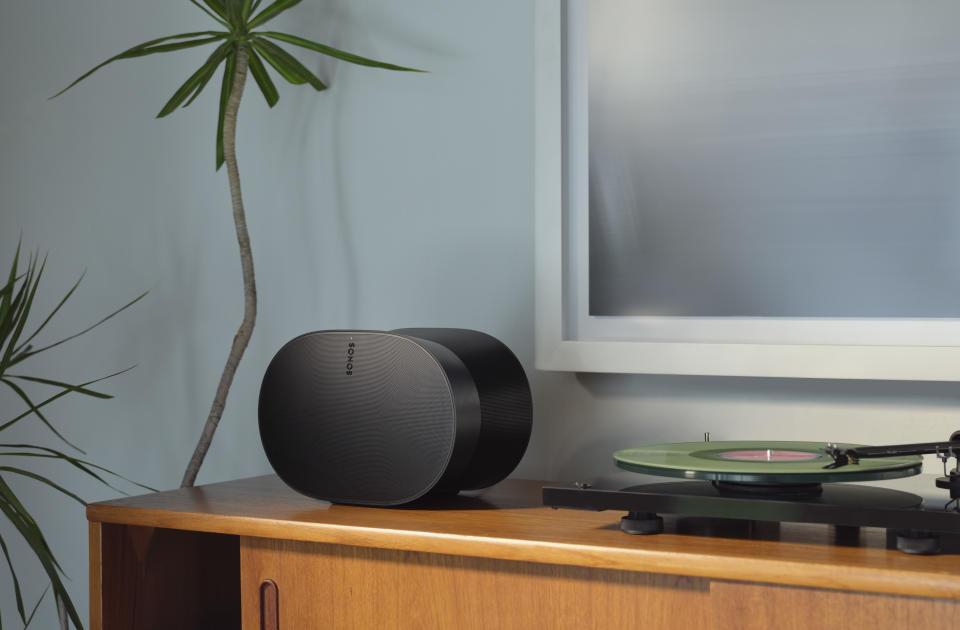
The great thing about Sonos is not only its wide range of products, long list of streaming services, user-friendly app and set-up, and consistently impressive performance; it’s also that your system can constantly grow – whether that's through adding wireless speakers to your soundbar set-up or planting them in another room. And if you want to add voice control into the mix, it's a seamless process.
While no longer compulsory, we would recommend anyone committed to the multi-room cause to hardwire at least one (a ‘master’) speaker to your network router, so you can take advantage of the proprietary peer-to-peer mesh network that makes Sonos so reliable. Alternatively, the more powerful Sonos Boost (£99) is designed to make your wi-fi signal twice as robust – ideal for large houses and thick walls.
It's worth noting that the Sonos S2 app supports 24-bit/48kHz streaming via Qobuz and Amazon Music Unlimited. The Sonos S2 app already lets users play 24-bit files from a local drive, but now users can stream hi-res tracks from either music service.
Should you buy the Sonos multi-room system?
As an entire ecosystem, Sonos is hard to fault – if you don’t mind sacrificing high-resolution audio support across the board, of course. The new app update seems to have some teething issues, but the system, as a whole, works well and is supremely versatile, even with product prices increasing recently. Add in the fact that you get access to the world's widest range of music services, and it's an ecosystem to be reckoned with.
Read our Sonos multi-room system review
How about Sonos alternatives?
Sonos is far from the only option when it comes to choosing a multi-room system. The company may have been first, but big players such as Bose, LG and Yamaha, and hi-res supporting brands, including Bluesound and Denon with their BluOS and HEOS (respectively) platforms, have since joined the fray.
The increasingly popular (and cheaper) smart speakers from Amazon and Google also offer multi-room streaming across their various voice-controlled products, while the Apple HomePod 2 and HomePod Mini boast exceptional multi-room powers thanks to AirPlay 2 (which Sonos also has in select products).
While most rivals may not have been able to topple the multi-room giant and Sonos remains the most recognisable name, many wireless products these days now come with some kind of multi-room feature as standard – whether that's through AirPlay, BluOS support or otherwise, so it's now easier than ever to create a multi-brand, multi-product multi-room system.
Check out our full 'everything you need to know about Sonos' guide for an A to Z on the company's ecosystem and its alternatives.
MORE:
Save big with this week's best Sonos deals
Our verdict on the best Sonos alternatives
Read our new Sonos Ace wireless headphones review
Brush up your skills: 32 Sonos tips, tricks and features
